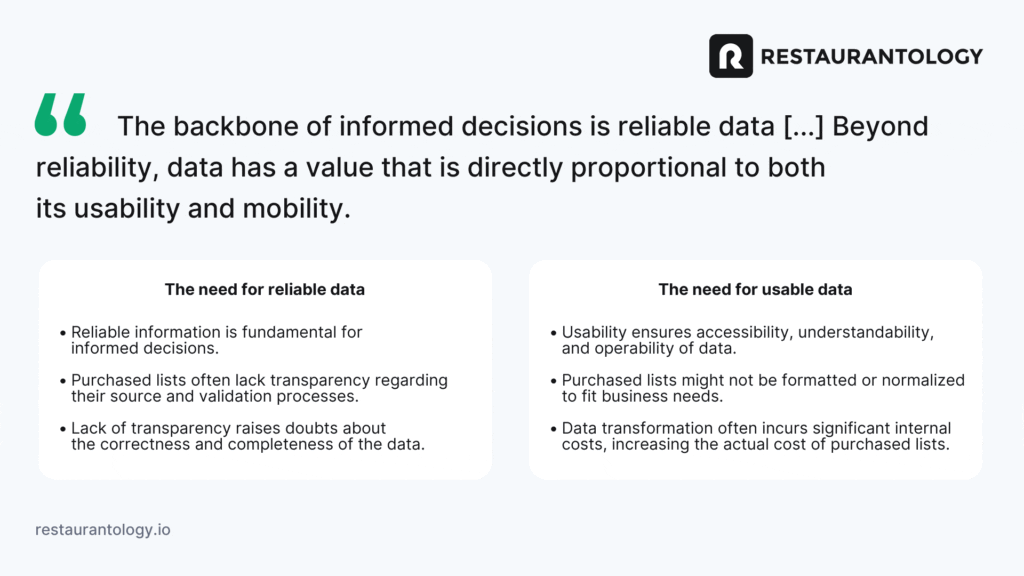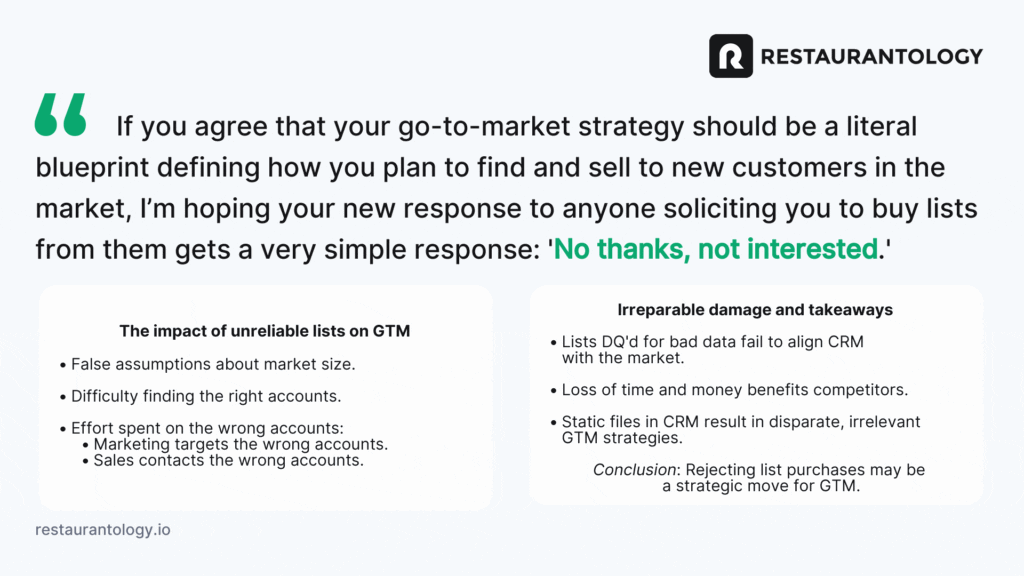List purchase is ruining your GTM

Purchasing lists has been the “go-to” for restaurant tech go-to-market (GTM) strategies. But can modern SaaS companies really depend on flat files to generate nimble GTMs? The short answer is no, not really.
In the previous office hours we discussed how the default data acquisition strategy for restaurant tech CRMs is to use manual updates—and perhaps a few sporadic marketing event imports—to keep pace with the industry. This is hopeful, at best. And hope is not a strategy.
We also talked about the importance good data plays on the reliable outcomes expected of GTM strategies, which helped us commit to fixing bad data at its source.
But as companies begin the process of eliminating bad market data in their CRM, there’s a decades-old habit of turning to fragmented, moment-in-time CSVs and praying they auto-magically fix your data problem. Some companies buy lists because it’s all they’ve ever known. Others want Excels because they seem cheaper and faster than anything else.
How do I know people overestimate the power of market lists? Because I used to, too. I downloaded them for years.
Regardless of why you may have turned to purchasing market snapshots or industry reports in the past, I’m here to challenge this thought process. Your business deserves better. And so do you.
Can’t help, won’t help
Consideration: Lists are a poor way to acquire data, and a terrible way to do so repeatedly.
For over a decade, companies have collectively deprioritized purchasing static lists of emails. They’re cheap, they’re bad, and they bounce. Instead, a growing consensus has aligned with their more modern, on-demand counterparts—Zoominfo, Clearbit, Seamless.AI to name a few—because they validate fast, keep confidence high, and export/import easily.
Why is this not the norm for purchasing market intelligence? That’s an honest question.
If you agree your CRM data doesn’t reflect the industry, assuming you choose to do something about it, there are two paths forward: purchase a list, or find a partner that can integrate better data to fix bad data at its source once and for all.
For companies of all shapes and sizes, the first impulse to address bad data is to turn to one of two industry monoliths looking for a cheap, quick fix. I’ve come to find that this is something of a learned behavior in restaurant tech, and I’m of the faith that anything learned can be unlearned.
It’s time to unlearn purchasing lists.
2 reasons why list purchase will fail you
When you begin assessing how to fix your data problem, you’ll recognize you need a dataset that represents the market you serve. When evaluating any dataset, your primary focus should be on:
- the reliability of the data, and
- base-state usability.
Another way to think of this is, “is this good data, and if so, is there any friction making it difficult to use?”
Data must be reliable
The backbone of informed decisions is reliable data. As I stated in the previous Office Hours, acquiring reliable data should be seen as a strategic imperative to support big initiatives like ongoing market segmentation and long-tail ABM.
Are purchased lists likely to have accurate, reliable data? Let’s see…
As someone who specializes in data acquisition, I know all too well that static lists are sold as-is, and will be impossible to assess for correctness and completeness prior to purchase. They will also lack any semblance of transparency in terms of their source, and will obscure the recency/frequency with which key fields are validated, where, by whom, and when they will be validated again should you need future updates.
Without the ability to properly evaluate a dataset beyond a startlingly-scrubbed sample, list reliability remains a coin flip and something I personally refer to as “bad data for-pay.”
So are lists likely to have accurate, reliable data? No, they are not.
Learn more about finding and vetting market intelligence here →
Data must be usable and moveable
Beyond reliability, data has a value that is directly proportional to both its usability and mobility. Usability ensures that data is readily accessible, understandable, and actionable for decision-makers across the organization. Mobility emphasizes that data is agile, integrated, and future-proof as companies grow and business needs change.
Are purchased lists likely to be usable and moveable without significant internal manipulation? Let’s see…
The odds of you receiving a file that is formatted and normalized to your business needs is slim, perhaps even non-existent. This is also a problem that compounds greatly should you have more than one vendor, a vendor that sends you exports repeatedly, or a “partner” offering you unlimited downloads from an online portal. The latter, to be clear, is nothing more than glorified self-serve list purchase.
Data transformation required to derive insights, extract meaning, or prepare for import has an implicit cost, and you are likely the one paying for it. If you were to add this cost to a quoted file or list, it might not seem so cheap or simple after all.
So are purchased lists likely to be usable and moveable without significant internal manipulation? No, they are not.
Learn more about ingesting market intelligence here →

Your GTM deserves better
If the impracticality of purchasing lists as a way of acquiring market data hasn’t already set in, perhaps it’s worth considering just how detrimental of an impact unreliable lists can have on every aspect of a GTM strategy.
Basing future business growth on incorrect or incomplete market intelligence can lead to a cascade of negative effects on your desired GTM outcome, including:
- Misguided decision making → we thought there were more accounts
- Wasted resources → we were calling the wrong accounts
- Ineffective marketing → we were targeting the wrong accounts
- Sales inefficiency → we were emailing the wrong accounts
- Segmentation challenges → we can’t find the right accounts
- Delayed time-to-market → we took too long finding the right accounts
- Reduced competitive advantage → we took too long selling the right accounts
- Undermined long-term growth → we’re not sure if these are the right accounts
Some of these problems can be resolved in time, however others—when you have bad data sitting in aged lists fueling your GTM—could cause irreparable damage to your business. Two examples of this would be:
- If the list is ultimately DQ’d for bad data, then you didn’t solve what you originally set out to do, which was align your CRM with the market you serve.
- You can never get the time and money dedicated to list purchase back, and could consider both a gift to your competitor and their market advantage.
How’s that sit with you?

Conclusion
List purchase has a high probability of giving you data that is both unreliable and unusable (without significant investment), which happen to be the two leading reasons why static files never make it into the CRM. And without proper market intelligence in your system of record, GTM strategies become disparate spreadsheets scattered across teams and inboxes destined to become irrelevant, insignificant, and inconsequential.
If you agree that your go-to-market strategy should be a literal blueprint defining how you plan to find and sell to new customers in the market, I’m hoping your new response to anyone soliciting you to buy lists from them gets a very simple response:
“No thanks, not interested.”


